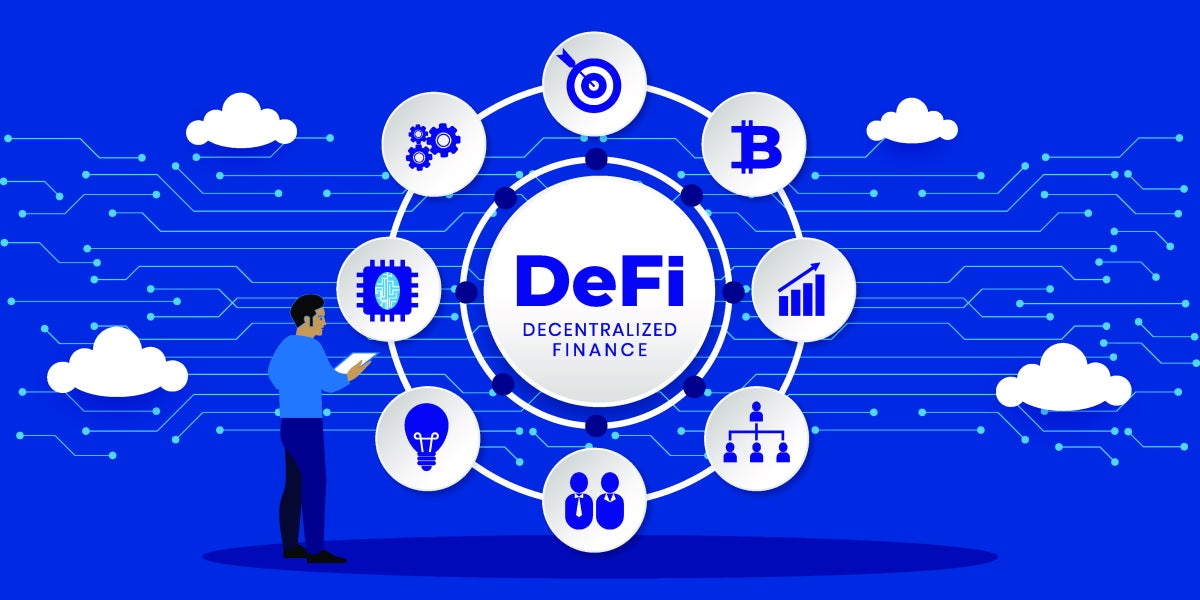DeFi ( Decentralised Finance ), refers to a new generation of financial systems that operate through smart contracts, eliminating traditional financial third parties such as banks and brokers, and allowing users to engage in all types of financial activities (also known as “peer-to-peer”) directly with the user, including trading, lending, insurance and more. including trading, lending, insurance, etc. As you can see, DeFi is not a specific project, but an industry with many branches.
The birth of DeFi can be traced back to Bitcoin, as transferring payments with Bitcoin (Bitcoin) is also a decentralised financial activity in the broadest sense of the word, but it’s widely believed that DeFi really began with the emergence of smart contract functionality on the Ether network (Ethereum).
In late 2017, people started building decentralised applications (DApps) on the Ethereum network, including financial DApps, which marked the birth of DeFi; in 2020, the DeFi ecosystem expanded further; and in 2021, there was explosive growth with a large number of projects emerging.
DeFi Principle
The DeFi application runs on the public blockchain (primarily Ether) and allows users to interact with smart contracts directly from their cryptocurrency wallets. These smart contracts are self-executing contracts where the terms of the agreement are written directly into the code. They automate the execution of the protocol so that all participants can determine the outcome immediately without the involvement of any intermediary or loss of time.
The framework supports the creation of decentralised applications (DApps) that provide financial services without the need for a central authority.
Decentralised Finance (DeFi) has become a ground-breaking movement, redefining the boundaries of financial services through its blockchain-based solutions. By democratising financial instruments, DeFi promises to make banking and investment opportunities universal, challenging the status quo of the traditional financial ecosystem.
However, like any innovative technology, DeFi comes with its own set of challenges and risks. Understanding these benefits and risks is critical for anyone who wants to effectively navigate the DeFi space. Below is an overview to aid in that understanding:
DeFi Benefits
Accessibility: DeFi provides financial services globally, especially to the unbanked.
Transparency: Blockchain technology ensures that all transactions are transparent and auditable by anyone.
Innovation: The DeFi ecosystem fosters innovation, introducing new financial products and ways to earn returns.
No Permission Required: Users do not need to be approved by a central authority to interact with DeFi applications.
Interoperability: Many DeFi protocols are built to work together, increasing their utility and efficiency.
DeFi Disadvantages
Smart Contract Vulnerabilities: Errors or vulnerabilities in smart contracts can lead to significant financial losses.
Market Volatility: The DeFi market may experience high volatility and rapid price changes could lead to potential losses.
Regulatory Uncertainty: The changing regulatory environment may affect the operation and accessibility of DeFi services.
Liquidity Risks: Some DeFi platforms may face liquidity issues, affecting the ability of users to withdraw funds.
Scalability Issues: As DeFi grows, the underlying blockchain infrastructure may not be able to cope with the growing demand.
DeFi Coin
DeFi is a larger blockchain application segment that can be subdivided into Trading, Lending, Derivatives, Insurance, Prophecy Machines, etc., where each sub-segment of DeFi has many different projects which basically have corresponding tokens.
- Trading
DeFi’s trading segment focuses on Decentralised Exchange (DEX), which allows users to trade all types of virtual currencies peer-to-peer and to control the assets themselves, without being controlled by centralised bodies like Binance and Coinbase. According to CMC, there are about 380 DEX platforms, and some of the better-known projects are Uniswap (UNI), PancakeSwap (CAKE), Curve (CRV), and for DEX aggregator 1inch.exchange (1inch). (DEX Aggregator, refers to bringing together multiple DEX platforms to help users close deals quickly and at low rates.) - Derivatives
Derivatives in DeFi are financial contracts that provide the right to buy and sell based on cryptocurrencies. Essentially, Derivatives in DeFi is also a trading platform that offers trading in derivatives such as synthetic assets, futures, options, etc., whereas DEX targets spot trading. The more popular derivatives are Synthetix (SNX), dYdX (DYDX), and GMX (GMX), with the former mainly offering synthetic assets and the latter two mainly targeting perpetual contracts. - Lending
Similar to the lending in traditional finance, DeFi world also has lending (decentralised lending), except that it does not involve financial institutions, but matches borrowers and lenders through smart contracts, and the borrower pays interest to the lender directly. There are two types of lending and borrowing in DeFi: mortgage lending and credit lending, and the main projects focusing on lending and borrowing business are Maker (MKR), Compound (COMP), Aave (AAVE), and the aggregator for lending and borrowing, year.finance (YFI). - Insurance
Insurance on DeFi is similar to real-life insurance, in that you can reduce your losses by claiming compensation when you lose assets due to hacking, technology, etc., provided that you have bought the corresponding insurance. The insurance items are inSure (SURE) and NexusnMutual (wNXM). - Prophecy Machine
The most neglected part of DeFi is the prophecy machine, but it is an essential and important part of keeping DeFi functioning properly. Through the prophecy machine, DeFi can obtain off-chain data or external data, especially the price data (commonly known as “feed”) provided by the prophecy machine, otherwise there will be obvious price difference (DEX), unable to trade (synthetic assets) and other problems. The main prophecy machine projects are ChainLink (LINK), BandProtocol (BAND), NESTProtocol (NEST).



